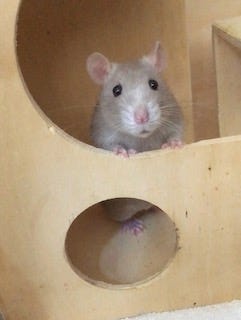If you follow rat social media, it won’t be long before you see a pet rat in a harness trekking across a grassy lawn like a tiny dog. It’s adorable. However, even if the rat likes the harness (hard to imagine) and enjoys being outdoors (very unlikely), you probably should never exercise your rats outside, let alone take them on walkies. Here’s why:
It scares the rats! Rats get fearful of new, open spaces, especially when these spaces are brightly lit. Through gentle exposure over a period of many sessions, it may be possible for a tolerant domestic rat to habituate to outdoor open spaces, but it would be very stressful for it.1
Exposure to some natural light is good for rats, but rats are very sensitive to both sunlight and bright light. Rat cages should not be placed next to windows for this reason alone. Rat owners have reported swelling in the tissue of rats’ eyes after exposure to periods of direct sunlight through windows. Rats with low eye pigmentation (pink and ruby eyes) appear to respond even more dramatically to direct sunlight and studies looking at exposure to bright light show areas of the retina becoming unstable so that the eye degenerates over time even when exposure to damaging light is curtailed.2
Exposing your rats to the outdoors can result in them contracting illnesses that may not make them ill, but can make you ill! In 1985, studies showed 14% of wild rats in UK farmlands carried leptospirosis, an illness that can be passed onto you. I suspect that number (14%) would be much higher in waterways.3 Your rats won’t necessarily show any symptoms of the illness, but leptospirosis, or Weil’s disease as it is called in humans, carries a 5% fatality rate in the UK and can be higher.4 In addition to leptospirosis, if your rats happen to come into contact with urine from wild rats, they are potentially exposed to at least “13 known zoonotic and 10 non-zoonotic parasitic species, many of which (e.g. Cryptosporidium, Pasteurella, Listeria, Yersinia, Coxiella and Hantavirus) have rarely or never been previously investigated for wild rats.”5
Your rat may escape! Rats might lumber around at reasonable paces when at leisure, but if they get frightened, they can put on the power. Laboratories have recorded the speed of rats running at 105 meters a minute just as a matter of course, not because they were testing maximum speeds.6 If lost, our fancy rats have more time to contract illnesses transmissable to humans, though they don’t survive very long outdoors. Either they die of starvation, exposure and disease, or they are killed by predators.
Rats are subject to some of the same viruses that dogs get, but aren’t protected by vaccinations. Bordetella bronchiseptica, or Kennel cough, for example, will often kill pet rats. Even if the rat has been exposed only to the live attenuated virus (through contact with urine from a recently vaccinated dog for example) they can contract this disease and it is deadly to them.7
Ennaceur, Abdel & Michalikova, S & Chazot, Paul. (2008). Do rats really express neophobia towards novel objects? Experimental evidence from exposure to novelty and to an object recognition task in an open space and an enclosed space. Behavioural brain research. 197. 417-34. 10.1016/j.bbr.2008.10.007.
Rutar, M., Provis, J. M., & Valter, K. (2010). Brief Exposure to Damaging Light Causes Focal Recruitment of Macrophages, and Long-Term Destabilization of Photoreceptors in the Albino Rat Retina. Current Eye Research, 35(7), 631–643. https://doi.org/10.3109/02713681003682925
Webster, Joanne & Macdonald, David. (1995). Parasites of wild brown rats (Rattus norvegicus) on UK farms. Parasitology. 111 ( Pt 3). 247-55. 10.1017/S0031182000081804.
Tidy, C. (2024). Leptospirosis. [online] Patient.info. Available at: https://patient.info/doctor/leptospirosis-weils-disease# [Accessed 8 Sep. 2024].Webster, Joanne & Macdonald, David. (1995). Parasites of wild brown rats (Rattus norvegicus) on UK farms. Parasitology 111 ( Pt 3). 247-55. 10.1017/S0031182000081804.
Webster, Joanne & Macdonald, David. (1995). Parasites of wild brown rats (Rattus norvegicus) on UK farms. Parasitology. 111 ( Pt 3). 247-55. 10.1017/S0031182000081804.
Armstrong, R.B. and Laughlin, M.H. (1985). Rat muscle blood flows during high-speed locomotion. Journal of Applied Physiology, 59(4), pp.1322–1328. doi:https://doi.org/10.1152/jappl.1985.59.4.1322.
Bemis DA, Shek WR, Clifford CB. Bordetella bronchiseptica infection of rats and mice. Comp Med. 2003 Feb;53(1):11-20. PMID: 12625502.





